|
Commented pictures of the Chalice stones (Kelchsteine) in Oybin, Saxonia, Germany, they give examples for the genesis of Pseudotectonics in other rocks. |
Back to I |
||
Bild 1 BKelch01.jpg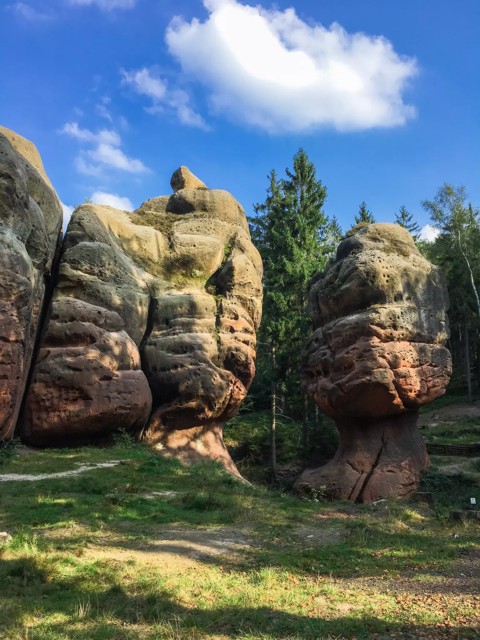 The Chalices stones in Oybin show clear pseudotectonics in the sedimentary sandstone. Right the name giving Chalice stone, left the Chalice stones Guardians. View from direction WSW. Location: 50.833177, 14.741476 Imagefile date Datum: 02.05.2020 Zeit: 16:24 |
Bild 2 BKelch02.jpg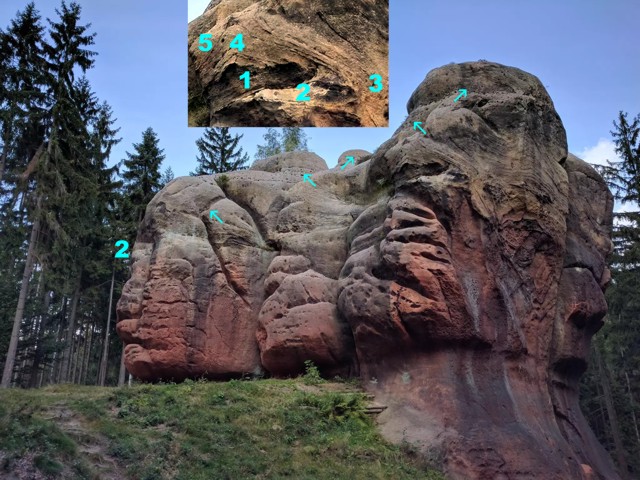 The Chalice stones Guardians seen from south. Arrows, directd to left and top, show upgoing algae strips. Arrows, directed to right and top, show changed direction. 1: A hump of balled algaes is sitting. 2: Underlaying matter like at the left edge with same number. 3: Traffic jam of coming algae strips, deflection to top. 4: Growth over hump 1. 5: Falling down after passing 4. With this mode sedimentation with algaes and streaming builds Pseudotectonics! Imagefile date Datum: 02.05.2020 Zeit: 18:56 |
Bild 3 BKelch03.jpg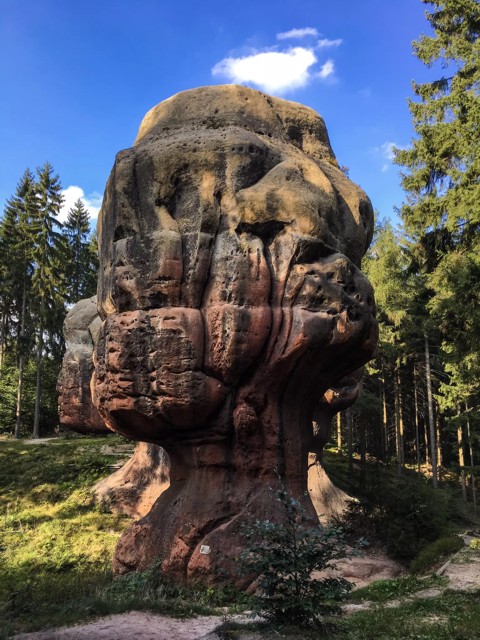 The chalice stone seen from SSE. 6 bankings can be defined. Below, partly in the floor, a thicker plinth. Above this is the lean stem bank, followed by three fat algae banks. The top bank is between in terms of algae content classified lean and fat. Fat banks have limited cracks due to the biodegradation of algae arise during sedimentation. Here one can even speak of limited gaps. It is an excellent one example of bio-sedimentary pseudotectonics. In such pseudo-clefts, a 2nd algae growth can occur by inflow and grow from above. Imagefile date Datum: 02.05.2020 Zeit: 16:41 |
Bild 4 BKelch04.jpg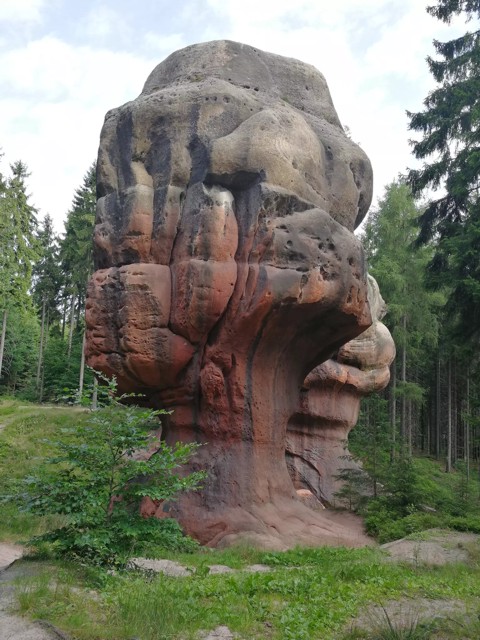 The chalice stone seen from SSO. The rain-protected areas on the chalice stone show a consistently high hematite content. Without material examination of the upper banks cannot be determined whether the hematite content in them is lower or only that weathering, rinsing and decolorization by humic acids caused the decolorization. Fine grain hematite clusters in rocks are also an indicator of biogenesis in rocks previously considered plutonic. The heavy metal affinity of algae and the fertilization of algae with iron sulfate are known. Imagefile date Datum: 02.05.2020 Zeit: 16:44 |
Bild 5 BKelch05.jpg In the circle at the bottom left, the direction of view past the Chalice stone is marked to the wall of the southernmost Chalice stone guardian. In the middle of the picture, a steep ledge protrudes. Cause can be a deportation over a right-hand side be sink. A drop of just a few decimeters is enough for the deportation to continue for several meters. The sink, which initially penetrates upwards, can be compensated with sediment later. The rock visible here shows one enormous number of spheres, which also indicate the biogenic cause. Imagefile date Datum: 03.05.2020 Zeit: 12:15 |
Bild 6 BKelch06.jpg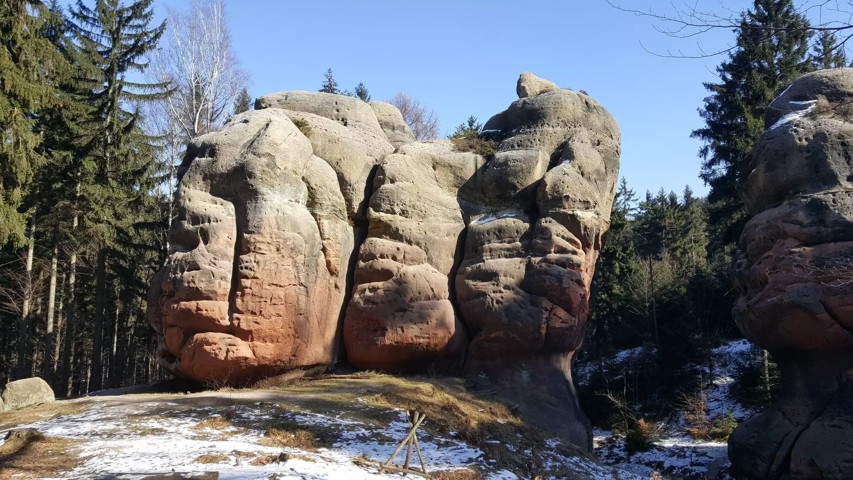 View from WSW to the Chalice stone guardians. On the left were rising algae strips on the now lost filling of one large hole blocked. The left guardian is less clearly banked in comparison to the 3 fat banks in the right Chalice stone. In the middle of the group, the sand of weathering hides the "lean stem bank" below. Imagefile date Datum: 02.05.2020 Zeit: 16:52 |
Bild 7 BKelch07.jpg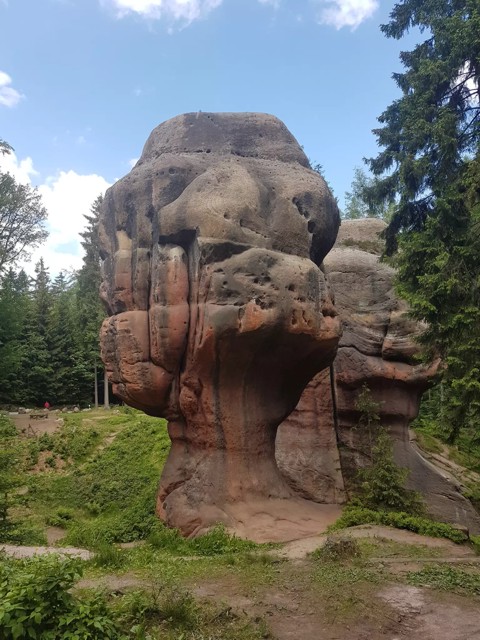 View from the south to the Chalice stone and the southeast corner of the guardians group. On the left, the upper limit of a gap is very clear visible. To the right, approximately in the upper middle, strips of algae form the figure of a mirrored S. To the right we see the south-east corner of the guardians with a lowering of layers above a depression. The material of the depression was already lost during the sand deposit. The cause can be leaching by less cohesion. The depression is filled with sediment less algae some meters above. Imagefile date Datum: 02.05.2020 Zeit: 16:56 |
Bild 8 BKelch08.jpg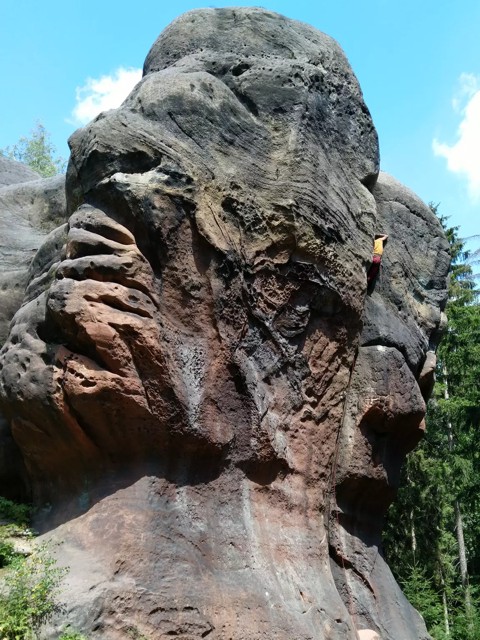 Similar to picture 5, the south-south-east wall at the guardian. Left: Conversion of hematite (red) to yellow limonite by rain water. Below: White veils, probably secondary mineral formation of scorodite (iron arsenate containing crystal water), by weathering of arsenopyrite. Mountaineers will not climb there due to low rock strength, so the toxicity has little meaning. There may be a large ball formation with balls enclosed a bit right of the center of the picture. On the right a mountaineer in the NNW-SSE main gap. Somewhat to the right of the center of the picture and starting at the climber's head height vertically algal growth through layers up to a height of about 3.5 m. Imagefile date Datum: 02.05.2020 Zeit: 17:09 |
Bild 9 BKelch09.jpg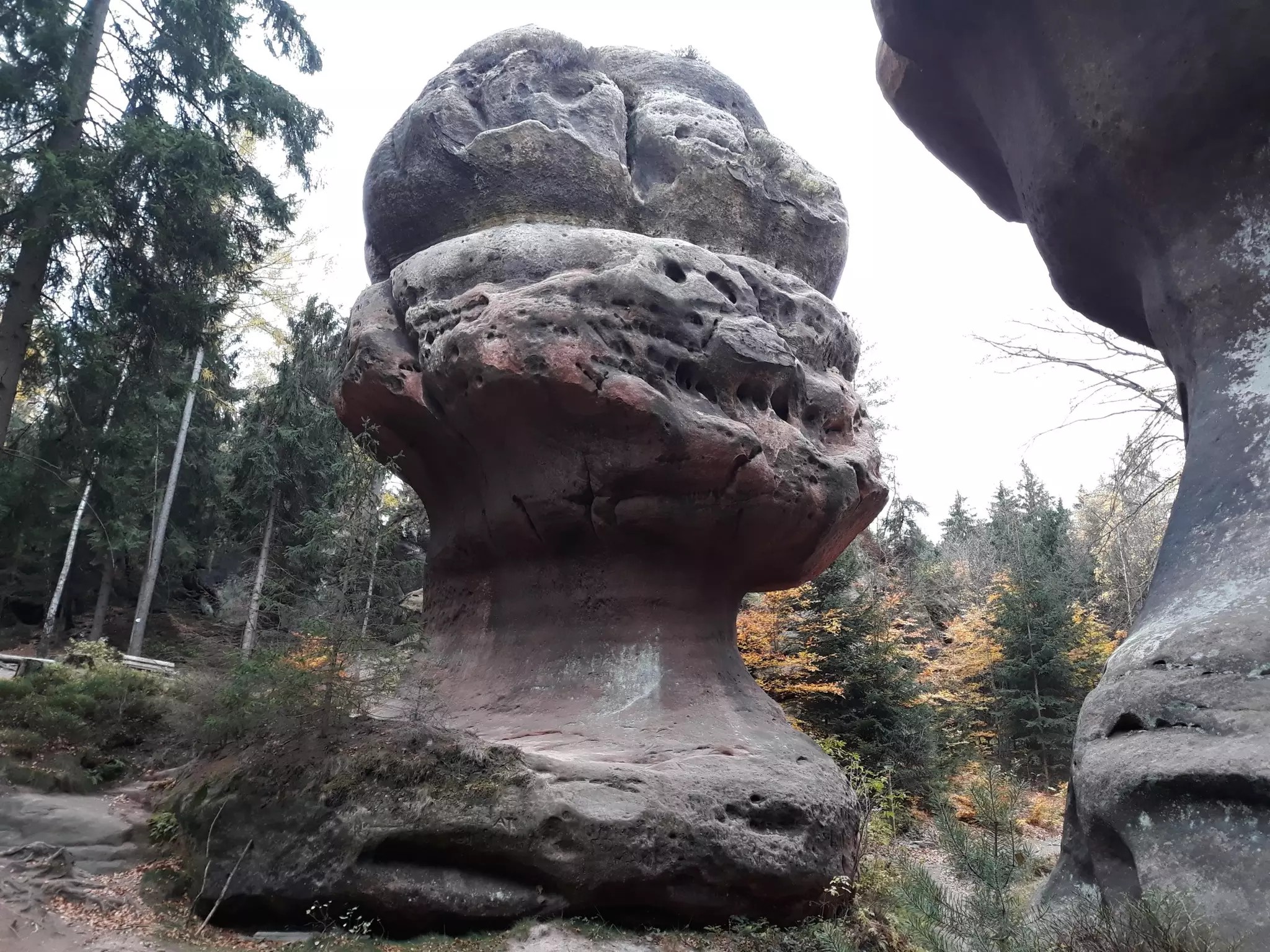 The Chalice stone from the northeast: Due to the rain that often comes from the north, hematite is washed away more, also at the base. The "pig nose" in the middle was created by algae growth around the now missing stuff of the nostrils. A higher quartz content in the binder makes the sandstone more stable there. There are numerous balls in the plinth. Imagefile date Datum: 02.05.2020 Zeit: 17:17 |
Bild 10 BKelch10.jpg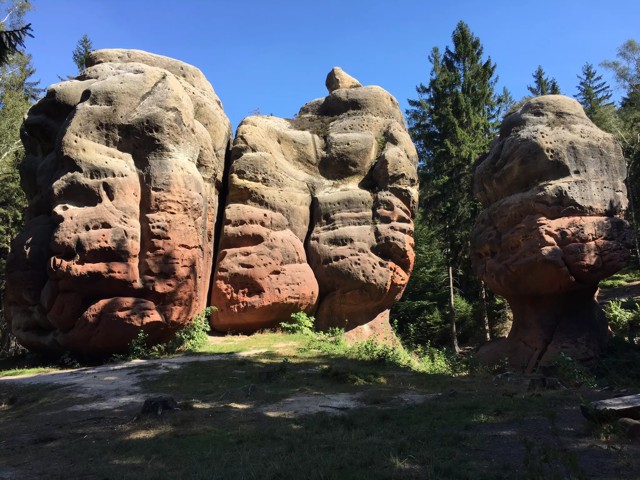 Here we see the linearity of the WSW-OSO gap of the Guardian stones. The hematite layer in the cleft was penetrated by water until soil and turned into limonite. A Part of the lower surface of the Guardian stones is with unnecessary scratches from human hands disfigured. Imagefile date Datum: 02.05.2020 Zeit: 17:15 |
Bild 11 BKelch11.jpg The gap in Figure 10 in detail: The conversion of hematite to limonite is present on both sides. Layers extending vertically on the gap walls already arise during sedimentation. The gap created by degradation of organic stuff is widening progressively. Algae and sediment penetrate from above and partially fill the gap. The massive appearance of chondrons is not surprising. This process, for which the sandstone provides an example here, was also in part of the supposedly hydrothermally filled ore fissures effective in Freiberg gray gneiss! Imagefile date Datum: 02.05.2020 Zeit: 17:19 |
Bild 12 BKelch12.jpg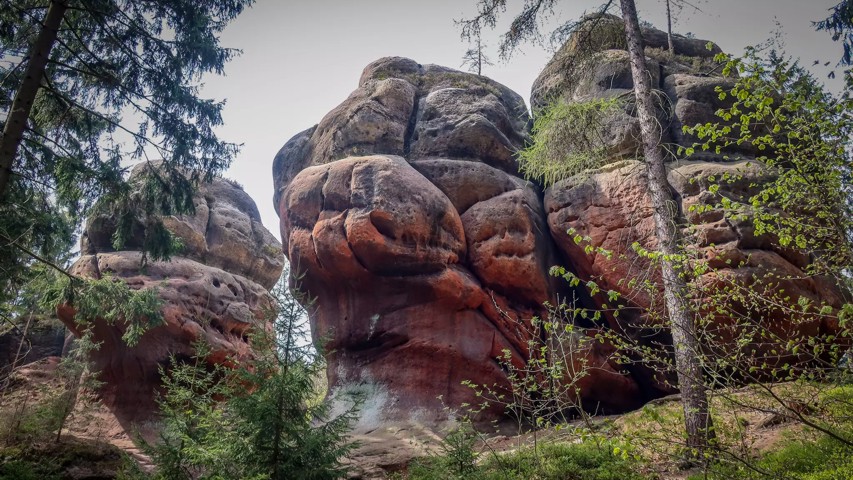 The Chalices stones seen from the east: If we consider the bulging "extension" to the left of the center of the picture as a particularly fat part of a fat bank, then the ending of the vertical cracks below and above it is not surprising. These limited cracks are also clearly visible on the left of the Chalice stone above the pig's nose. Where less algae were stored in lean areas and less organic material was biodegraded, the sediment did not crack. Imagefile date Datum: 02.05.2020 Zeit: 17:27 |
Bild 13 BKelch13.jpg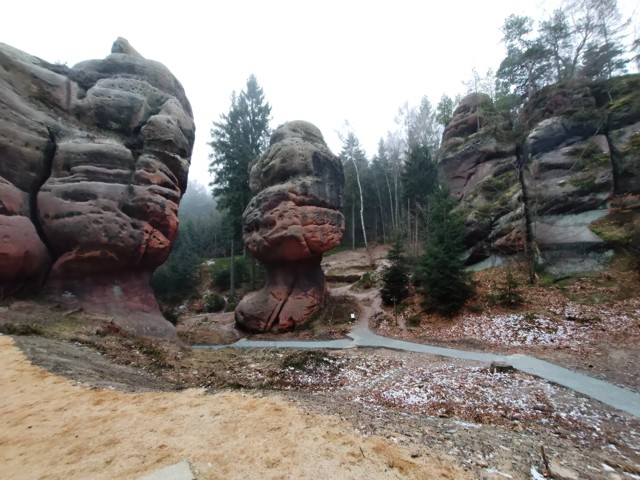 The Chalice stones with a neighboring rock group, on the right in the picture, seen from the west. The rock group is from left to right about ESE-WSW directed. It can be seen that the banks of the rock group correspond approximately to those of the Chalice stone. The direction of the two fissures matches the main divide of the Guardian Stones and the right face on the Chalice Stone. The blackening of the right surface on the Chalice stone is based on dead of recent algaes. Imagefile date Datum: 02.05.2020 Zeit: 17:33 |
Bild 14 BKelch14.jpg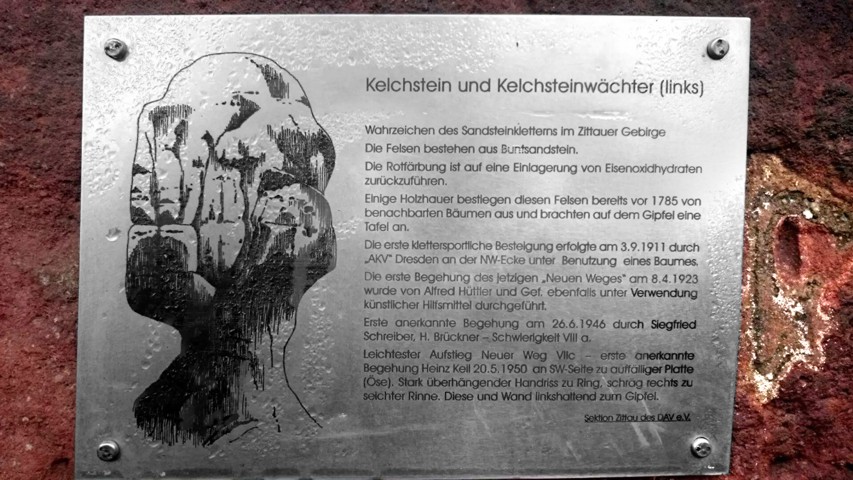 Information board for the Chalice stones: "The rocks are made of Buntsandstein." This sentence is geologically questionable. Buntsandstein is a historical, geological, structure of the Germanic Triassic. The sandstone here is much younger cretaceous Elbe sandstone, as in the Elbe Sandstone Mountains and in the neighboring country, the Czech Republic. Imagefile date Datum: 02.05.2020 Zeit: 17:58 |
Bild 15 BKelch15.jpg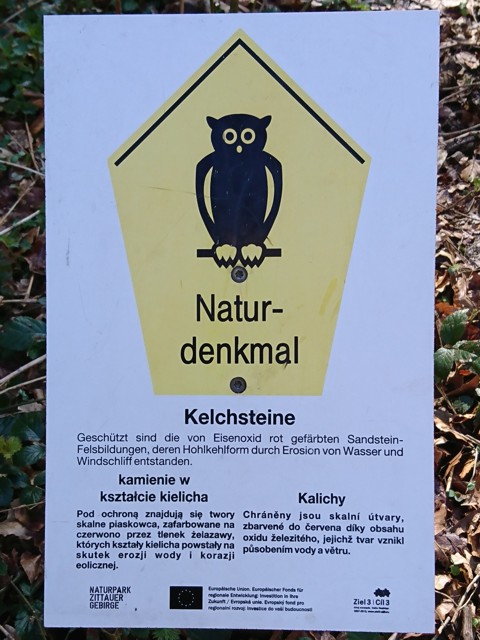 Informations and safety table for the Chalice stones. For geologists, the chalices have the potential to become a special "geotope" and to find their way into teaching materials. Imagefile date Datum: 02.05.2020 Zeit: 18:01 |
Bild 16 BKelch16.jpg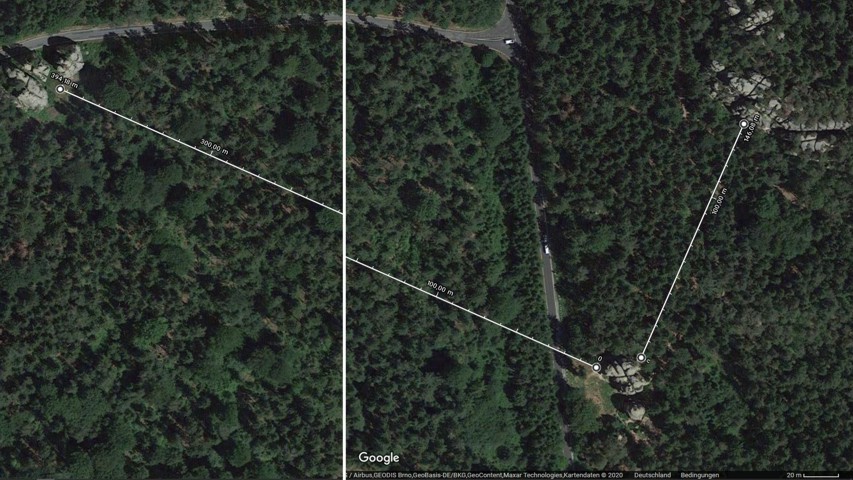 The Chalice stones, bottom right, on Google Maps. The bottom soloist is the Chalice Stone. Above the Chalice stones guardians. The forested rock group extends to the southwest of the Chalice stone, which can be seen in picture 13 on the right. Similar top right and left clefted rock groups. The oblique and linear divide cross of the chalice stones gives the impression that it is tectonic. However, the above visible rock clusters and cross twists are twisted towards each other. It follows that more fractures than previously assumed in the Elbe sandstone are caused by biosedimentary effects. Imagefile date Datum: 06.05.2020 Zeit: 11:33 |